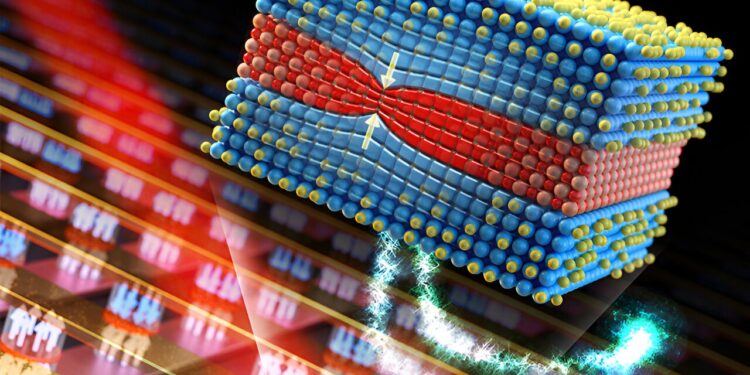For the first time, researchers have been able to observe a “pinhole” in a device and watch its degradation in real time. Credit: Mkhoyan Lab, University of Minnesota
A new study by researchers at the University of Minnesota Twin Cities provides new insights into how next-generation electronic components, including computer memory components, fail or degrade over time. Understanding why this degradation occurs could help improve the efficiency of data storage solutions.
The research is published in ACS Nano and appears on the cover of the newspaper.
Advances in computing technology continue to drive demand for efficient data storage solutions. Spintronic magnetic tunnel junctions (MTJs)—nanostructured devices that use electron spin to enhance hard drives, sensors, and other microelectronic systems, including magnetic random access memory (MRAM)—are promising alternatives for the next generation of memory devices.
MTJs have been the building blocks of non-volatile memory in products such as smartwatches and in-memory computing, with promise for applications in improving the energy efficiency of AI.
Using a sophisticated electron microscope, the researchers observed the nanopillars in these systems, which are extremely small, transparent layers inside the device. The researchers ran an electric current through the device to see how it worked. By increasing the current, they were able to observe in real time how the device degrades and eventually dies.
“Real-time transmission electron microscopy (TEM) experiments can be challenging, even for experienced researchers,” said Dr. Hwanhui Yun, first author of the paper and a postdoctoral research associate in the Department of Chemical Engineering and Materials Science at the University of Minnesota. “But after dozens of failures and optimizations, functional samples were consistently produced.”
In doing so, they discovered that over time, under the influence of direct current, the layers of the device pinch and cause the device to malfunction. Previous research has suggested this, but this is the first time researchers have observed this phenomenon. Once the device forms a “pinhole” (the pinch), it is in the early stages of degradation. As the researchers continued to add more and more current to the device, it melted and burned itself out completely.
“What’s unusual about this finding is that we observed this combustion at a much lower temperature than previous research thought possible,” said Andre Mkhoyan, lead author of the study and the Ray D. and Mary T. Johnson Professor in the Department of Chemical Engineering and Materials Science at the University of Minnesota. “The temperature was almost half the temperature previously expected.”
When the researchers looked more closely at the device at the atomic scale, they realized that materials of this size have very different properties, including melting temperature. This means that the device will fail at a very different time than previously thought.
“There has been a strong demand to understand the interfaces between layers in real time under real-world working conditions, such as applying current and voltage, but no one has achieved this level of understanding before,” said Jian-Ping Wang, lead author of the paper and the McKnight Distinguished Professor and Robert F. Hartmann Chair in the Department of Electrical and Computer Engineering at the University of Minnesota.
“We are very pleased to say that the team has discovered something that will have a direct impact on the next generation of microelectronic devices for our semiconductor industry,” Wang added.
The researchers hope that this knowledge can be used in the future to improve the design of computer memory units to increase longevity and efficiency.
In addition to Yun, Mkhoyan and Wang, the team included Deyuan Lyu, a postdoctoral researcher in the Department of Electrical and Computer Engineering at the University of Minnesota, Yang Lv, a research associate, Brandon Zink, a former postdoctoral researcher, and researchers from the Department of Physics at the University of Arizona.
More information:
Hwanhui Yun et al., Discovery of atomic migrations causing the breakdown of magnetic tunnel junctions, ACS Nano (2024). DOI: 10.1021/acsnano.4c08023
Provided by the University of Minnesota
Quote:Direct current device malfunctions lead to discovery that may improve microelectronic device design (2024, September 13) retrieved September 13, 2024 from
This document is subject to copyright. Apart from any fair dealing for the purpose of private study or research, no part may be reproduced without written permission. The content is provided for informational purposes only.



